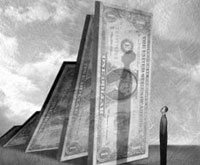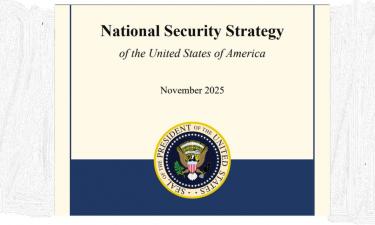US economy begins to falter slowly
Two reports released separately Friday -- one a measure of consumer spending and the other a snapshot of the industrial sector -- offered additional evidence that the U.S. economy is beginning to falter.

The retail-sales and industrial-production data, while softer than expected, were far from disastrous. But the reports, which were released on the eve of a policy meeting on a key Federal Reserve interest rate, added more fuel to widespread expectations that Fed officials on Tuesday will seek to give the flagging economy a boost by lowering short-term interest rates.
The Commerce Department said that retail sales increased 0.3 percent in August, a performance that fell far short of the 0.5-0.6 percent upturn experts had been expecting. What's more, a number of observers pointed out, excluding volatile transient factors, consumer purchases were even weaker than the overall figure indicated.
The 0.3 percent gain over last month's sales was driven by a hefty 2.8 percent jump in auto sales, and that upturn was largely spurred by carmakers' end-of-the-model-year price promotions.
Retail sales excluding autos actually declined 0.4 percent, the government said.
Sales dropped at building-material stores, for example, reflecting the housing industry's troubles. And sales at gasoline stations also declined, reflecting a welcome (if fleeting) drop in consumer fuel costs.
But sales of some other products, including furniture and electronic appliances, strengthened in August.
At bottom, the "soft" retail data, said Moody's Economy.com economist Scott Hoyt, seem to indicate that "consumers continue to grow their spending, but at a very modest pace."
"Clearly," he said, "the woes in housing, mortgage and financial markets are taking a toll on spending."
While Hoyt maintained that the retail report offered little evidence to suggest U.S. households were growing more tight-fisted in August, other economists took a slightly darker view.
"Consumers have certainly become more frugal," in response to the weaker housing market and higher costs for food and energy, observed Wachovia economist Mark Vitner. Retail sales, he said, had demonstrated "more fizzle than pop" in August.
The unexpectedly weak August data, while disappointing, were "not a disaster," echoed High Frequency Economics economist Ian Shepherdson.
"What matters now is the extent of any fall rebound," he said. But with consumer confidence dropping and the housing sector's collapse weighing ever more heavily on Americans, Shepherdson continued, "we expect a clearly slowing trend" in retail sales.
A gloomier report came from the Federal Reserve's data-collection group, which said Friday that industrial production rose 0.2 percent last month, falling short of the 0.3 percent upturn most economists had been expecting.
The report measures output from the nation's mines, factoriesand utilities. In August, unusually hot weather spurred a big but not particularly meaningful 5.3 percent increase in utility production.
Mining activity slipped 0.6 percent, however. And output from the nation's manufacturers -- by far the biggest segment in the index -- slipped by 0.3 percent, recording its first decline after five consecutive monthly increases.
The decrease in manufacturing reflects a drop in automobile production and, excluding autos, manufacturing slid a more modest 0.1 percent. Still, the pullback in the reading, which included softening production of consumer goods and business equipment, "could be an early warning sign for the U.S. economy," said BMO Capital Markets economist Sal Guatieri, chicagotribune.com reports.
As Pravda.Ru previously reported The U.S. runs budget deficits each year. If foreigners stop buying treasuries—or worse, start selling them—the dollar could be in big trouble.
The reduction in treasuries “comes as a big surprise and it is definitely worrying,” said Hans Redeker, foreign exchange strategy chief at bnp Paribas, one of Europe’s biggest banks.
The Telegraph reported that, according to Redeker, the numbers demonstrate “that world central banks are in a hurry to get out of the U.S.”
The nation that analysts are watching especially closely at this stage is China. Whether or not Beijing is selling its dollars can’t be officially confirmed until November, when the Treasury releases its tic data. However, top Beijing officials have been signaling for at least two years that dollar sales are increasingly imminent.
This past August, two Chinese government officials highlighted China’s massive U.S. dollar holdings (which include treasuries) and how it supports the value of the U.S. currency. They also noted that Beijing could use those holdings as a political weapon to counter congressional calls to revalue the yuan and impose trade sanctions on Chinese goods. Chinese state media referred to the country’s stockpile of U.S. dollars as its economic “nuclear option,” capable of destroying the dollar at will.
Beijing also clearly signaled that it would begin “diversifying” out of the dollar earlier this year when it announced plans to rebalance its $1.34 trillion currency reserves, which are mostly U.S. bonds. Already Beijing has created a $300 billion investment fund to use those dollars to purchase other assets in an attempt to increase its investment returns.
It should come as no shock, then, that China would now be selling its dollar holdings.
The danger, as the Telegraph notes, relates to the fact that China holds such a large amount of treasuries. Any confirmed evidence that China was no longer supporting the dollar, and was actually selling it, risks setting off “an unstoppable stampede” in which other nations would seek to dump their holdings before China swamps the market and demand for dollars is overwhelmed.
Source: agencies
Subscribe to Pravda.Ru Telegram channel, Facebook, RSS!





